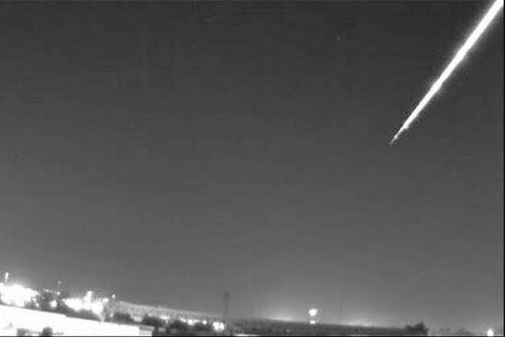A rock from an asteroid has entered sharply into the Earth's atmosphere at 9:32 p.m. on Monday, generating a brilliant fireball that has been seen from various points in Seville and Cordoba .
The rock that originated this phenomenon entered the atmosphere at about 61,000 kilometers per hour over the northeast of the province of Seville, an enormous speed that made it become incandescent, thus generating a bright fireball at an altitude of about 85 kilometers, According to the analysis conducted by astrophysicist José María Madiedo of the Institute of Astrophysics of Andalusia (IAA-CSIC), the researcher responsible for the Smart Project , which aims to continuously monitor the sky in order to record and study the impact against the Earth's atmosphere of rocks from different objects of the Solar System.
The fireball advanced in a northwest direction, passing almost vertically from the Sevillian towns of San Nicolás del Puerto , Alanís and Guadalcanal . Finally it became extinct over the province of Badajoz , when it was at an altitude of about 42 kilometers above the town of Zafra .
The fireball, visible from more than 400 kilometers away , has been able to be recorded by detectors that the Southwest Europe Meteor and Wind Network of the Smart project from the observatories of La Hita (Toledo), Sierra Nevada (Granada), La Sagra (Granada) and Seville . In addition, numerous witnesses, especially from the provinces of Seville and Cordoba, echoed this event through social networks.
The rock has completely disintegrated in the atmosphere after experiencing several explosions along its path, indicating that it has fragmented in the air, according to Madiedo. Thus, no fragment has hit the ground and, therefore, has not posed any kind of danger to the population .
The orbit that followed the rock before entering the Earth's atmosphere was very similar to that of the potentially dangerous asteroid 2000 QW7 , which approached Earth on September 14.
It is not ruled out, therefore, that the rock that generated the fireball was a fragment detached from that asteroid . However, confirmation of this extreme will require additional calculations, the astrophysicist has indicated.
According to the criteria of The Trust Project
Know more- science
- Science and Health
- Andalusia
Space Rolling Stones have their own stone on Mars
Meteorology Why (always) it is a bad idea to bomb a hurricane
Science Nuclear hurricane bombs: Donald Trump denies proposing this idea to protect the US

